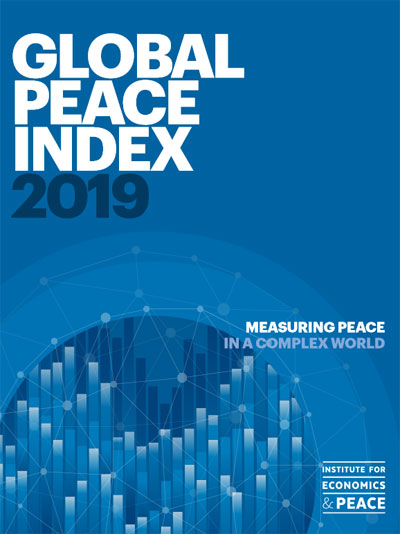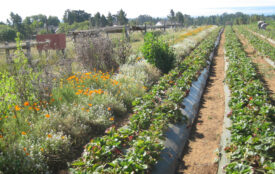Global Peace Index 2019
Global peacefulness improves for the first time in five years but world remains less peaceful than adecade ago.
Key Results
- Ukraine registered the largest improvement this year; Nicaragua the largest drop.
- More countries decreased their militarisation, 106 countries, than increased it –continuing a decade long trend.
- Since 2008 global peacefulness hasdeteriorated by 3.78 per cent, with 81 countries deterioratingand 81 improving, highlighting that deteriorations in peacefulness are generally larger than improvements.
Climate Change Highlight
- More than 400 million people live in areas with low levels of peacefulnessand high risk from climate change.
- Eight of the 25 least peaceful countries have 103 million at risk in high climate hazard areas.
- Regionally, sub–Saharan Africa has the weakest coping capacity for climate hazards, which could exacerbate violent conflicts.
GDP/Economic Cost of ViolenceHighlights
- The economic impact of violence on the global economy has decreased for the first timesince 2012, amounting to$14.1 trillionin 2018, or11.2 per cent or $1,853 for every person.
- Countries with very high levels of peace, on average, achieved over three times higher per capita GDP growth compared to the least peaceful countriesfor the last 60 years.
- In the ten countries most affected by violence, the average economic cost of violence was equivalent to 35 per cent of GDP, compared to just 3.3 per cent in the countries least affected by violence.
The 13thedition of the annual Global Peace Index(GPI) report, the world’s leading measure of global peacefulness, revealsthat theaverage level of global peacefulness improvedfor the first time in five years.However, despite improvement, the world remains considerably less peaceful now than a decade ago, with the average level of peacefulness deteriorating by nearly 4per cent since 2008.This year’s report includes new researchon the possible effects of climate change on peace.
Eighty-sixcountries improved their score in the 2019 report,whilst76 deteriorated.Iceland remains the most peaceful country in the world, a position it has held since 2008. It is joined at the top of the index by New Zealand, Austria, Portugal, and Denmark. Bhutan has recorded the largest improvement of any country in the top 20, rising 43 places in the last 12 years.
Afghanistan is now the least peaceful country in the world, replacing Syria, which is now the second least peaceful. South Sudan, Yemen, and Iraq comprise the remaining five least peaceful countries. This is the first year since the inception of the index that Yemen has been ranked amongst the five least peaceful countries.
Produced by the international think-tank the Institute for Economics &Peace(IEP), the GPI report presents the most comprehensive data-driven analysis to-date on peace, its economic value, trends, and how to develop peaceful societies. The report covers 99.7 per cent of the world’s population and uses 23 qualitative and quantitative indicators from highly respected sources to compile the index. These indicators are grouped into three key domains: Ongoing Conflict, Safety and Security, and Militarisation.
Steve Killelea, Founder and Executive Chairman of the IEP, said: “Although peace has improved in the 2019 GPI,a deeper analysis finds a mixture of positive and negative trends.Whilsttheconflicts that have dominatedthe past decade, such asinIraq and Syria,have begun to abate, new conflicts have emergedin Yemen, Nicaragua and Turkey,resulting inthe bottom ten countries in the index declining by more than the global average–increasing the global inequality inpeace.”
Four of the nine regions in the world became more peaceful over the past year. The largestincrease in peacefulness occurred in the Russia and Eurasia region, followed by the Middle East and North Africa. In both regions, the number of deaths from conflictdeclined in Ukraine and Syria respectively. The fall in conflict deaths has been mirrored by a fall in deaths from terrorism.
Two of the three GPI domains deteriorated over the past decade, with Ongoing Conflict deteriorating by 8.7per cent and Safety and Security deteriorating by 4 per cent. However, contrary to public perception, the Militarisation domain has recorded a 2.6 per cent improvement since 2008. The number of armed services personnel per 100,000 people has fallen in 117 countries, and military expenditure as a percentage of GDP fell in 98 countries, with only 63 countries increasing their spending.
Steve Killelea said:“Many of the trends recorded over the last decade highlight the complexity of global peace. Clearly it is good news thatstate sponsored terror has declined markedly over the last decade, with 62 countries improving their scores while only 42 deteriorated. However, incarceration shows the opposite trend with 95 countries inceasing the incarceration ratecompared to 65 that improved. The US has reduced its incarceration rate by 11 per cent over the last decade, however it still has the second highest incarceration rate in the world.”
The report also analysesthe security risks posed by climate change. Analsysisin the report finds that an estimated 971 million people live in areas with high or very high exposure to climate hazards, with 400 million of these people living in countries with low levels of peace. Ten per centof these people, or 103.7 million,are living in areas of countries ranked in the bottom 25 countries onthe GPI: South Sudan, Iraq, Libya, the Democratic Republic of the Congo, Sudan, North Korea, Nigeria and Mexico.
The economic impact of violence on the global economyin 2018 decreased for the first time since 2012, decreasingby 3.3 per cent, to$14.1 trillion.This figure is equivalent to 11.2 per cent of the world’s economic activity or $1,853 perperson. The largestimprovement was in armed conflict, owing to a fall in the intensity of conflict in Syria, Colombia and Ukraine. There was also a substantial reduction in the economic impact of terrorism, which fell by 48 per cent from 2017 to 2018.Forthe ten countries most affected by violence, the average impact was equivalent to 35 per cent of their GDP, compared to just 3.3 per cent in the world’s most peaceful countries. Syriasuffered the worst at 67 percent.
Regional overview:
- Peacefulness in Asia–Pacificimproved in all three GPI domains last year, largely due to increases in UN peacekeeping funding and reductions in violent demonstrations and deaths from internal conflict. However, the impact of terrorism continued to worsen, as did internal conflicts fought and external conflicts fought.Chinaclimbed two places to 110th, ahead of Algeria at 111thand behind Djibouti at 109th.
- Central America and the Caribbeandeteriorated in all three domains last year. Seven countries improved while five deteriorated, but as is typical of breakdowns in peacefulness, the deteriorations were larger than the improvements.
- Europe, theworld’s most peaceful region,became slightly more peaceful in 2018continuing its decade–longtrend. Twenty–two of 36 countries in Europe improved. Europe continues to dominate the top of the index, accounting for 17 of the 25 most peaceful countries.
- Peace in the Middle East and North Africa, the world’s least peaceful region,improved marginally last year, based on improvements in 11 countries. Syria is no longer the world’s least peaceful country, and recovery has started to materialise in Iraq.
- Peace in North Americadeterioratedlast year, recording the second largest regional deterioration. Canada showed a small improvement in overall score, but the deterioration in the United States was much largerand was dragged down by increases in the homicide rate, violent crime and political instability. While Canada remains one of the ten most peaceful countries in the world, the US fell four places to 128th–in between South Africa and Saudi Arabia.
- While most of Russia and Eurasiaremains less peaceful than the global average, it was one of three regions to improve in every domain of the GPI last year, resulting in the largest regional improvement.Russia fell by one place to 154th, ahead of the Democratic Republic of Congo at 155thand behind Pakistan at 153rd.
- Only Colombia, Uruguay and Chile improved in South Americalast year, while the rest of the region, another eight countries,deteriorated. Venezuela is now the least peaceful country in South America, and Brazil recorded the fifth largest fall globally.
- The average South Asianscore improved last year due to improvements in Nepal, Pakistan, and Bhutan.However, the region stillhas the second lowest rank, just ahead of its neighbour MENA.In sub–Saharan Africa,27of the region’s 44 countries deteriorated in peacefulness, leading to a weakening inall three domains of the GPI, while 12 of the region’s 23 indicators improved and eight deteriorated.
- For more information, visit www.visionofhumanity.org
- Global Peace Index (GPI) 2019










